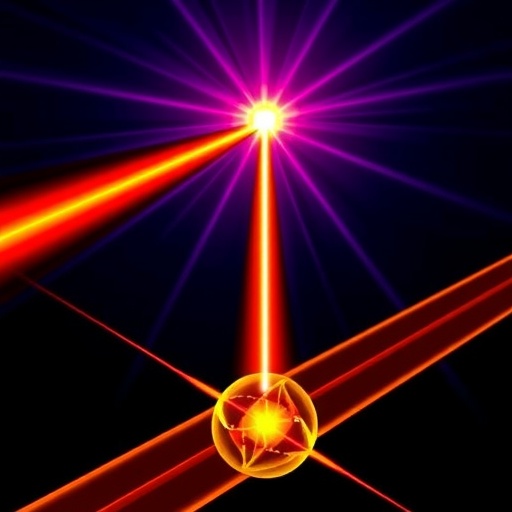Researchers in the field of plasma physics have made significant advances in the acceleration of electrons through innovative methods involving carbon nanotube (CNT) structured targets. Their recent analysis, published in Scientific Reports, explores the intricacies of self-injected electron acceleration, particularly under the influence of an 800 nm laser pulse. This groundbreaking study not only elucidates the mechanisms underpinning this phenomenon but also presents substantial implications for numerous applications within the realms of medical technology and high-energy physics.
In the rapidly evolving landscape of particle acceleration, the use of carbon nanotubes presents a promising alternative to traditional methods. The unique structural properties of CNTs, including their flexibility, high strength, and excellent conductivity, create an ideal environment for the dynamics of high-intensity laser interactions. The research team, led by Bonţoiu and his colleagues, delves into the numerical simulations that shed light on how these materials can facilitate the self-injection of electrons, enhancing acceleration processes worldwide.
The study leverages sophisticated numerical models to simulate the interaction between an intense 800 nm laser and CNT structured targets. The high-energy laser pulses generate powerful electric fields, which in turn induce significant plasma dynamics within the CNTs. As electrons are driven toward these fields, the conditions become ripe for self-injection, a mechanism where electrons effectively utilize the laser’s energy to propel themselves forward. This is particularly noteworthy, as it enables the electrons to achieve high velocities without the need for external acceleration sources.
The researchers detailed the step-by-step process of laser-target interaction, which begins with the incoming laser pulse striking the CNT. This initial event leads to the ionization of the surrounding material, creating a plasma medium. The subsequent complex interplay between the electric fields generated and the plasma dynamics is critical for the self-injection process. The simulations reveal that under optimal conditions, electrons are not only accelerated significantly but are also extracted from the plasma, marking a critical step in the realization of compact acceleration technologies.
One of the paramount findings from this research is the identification of the optimal parameters that enhance self-injection rates. The team discovered that adjusting the laser intensity, pulse duration, and the configuration of the CNTs could drastically influence the efficiency of electron acceleration. This discovery holds profound implications for the development of compact particle accelerators, which can be smaller and more cost-effective than their conventional counterparts.
The benefits of such advancements are multifold, extending to various fields including medicine. For instance, compact particle accelerators could revolutionize cancer treatment through their application in advanced radiotherapy techniques. Moreover, they can also contribute to the development of novel imaging systems that utilize accelerated electrons for high-resolution imaging, vastly improving diagnostic capabilities.
Additionally, the advances in electron acceleration due to CNT structured targets can pave the way for breakthroughs in fundamental physics research. High-energy particle collisions could open new avenues in the understanding of matter, anti-matter, and fundamental forces, potentially leading to significant discoveries that reshape current scientific paradigms. This potential for exploration into the unknown adds a thrilling dimension to the ongoing research in plasma physics.
Addressing the potential and challenges associated with implementing these findings forms a crucial part of the discussion surrounding this study. While the numerical simulations demonstrate promising results, translating these theoretical models into real-world applications requires overcoming several technical hurdles. Scaling the technology for practical use and ensuring stability and efficiency in various environments remain paramount.
The research community remains optimistic about the future prospects of this technology. As further experimental validation is conducted, the hope is to bridge the gap between simulation and practical application. This ongoing dialogue between theorists and experimental physicists will be essential in determining the viability of using CNTs for electron acceleration in diverse settings, including institutions and industry collaborations.
Furthermore, the study of self-injected acceleration within CNT structured systems invites further exploration into alternative materials and configurations. As research continues, the potential exists for discovering new materials that may offer even better properties than carbon nanotubes. This evolving landscape is indicative of the dynamism within this sphere of research, emphasizing the need for continuous innovation and exploration.
In conclusion, the work by Bonţoiu and his colleagues marks a significant contribution to the ever-evolving field of electron acceleration. Their findings pave the way for a remarkable future where compact particle accelerators, empowered by CNT technology, could transform medicine, deepen our understanding of the universe, and challenge the limitations of current physics paradigms. As scientific inquiry progresses, the implications of this research may indeed unlock avenues previously thought to be unattainable, reshaping not only technology but the very foundations of scientific knowledge itself.
Subject of Research: Self-injected electron acceleration in CNT structured targets driven by an 800 nm laser.
Article Title: Numerical study of self-injected electron acceleration in CNT structured targets driven by an 800 nm laser.
Article References:
Bonţoiu, C., Bonatto, A., Apsimon, Ö. et al. Numerical study of self-injected electron acceleration in CNT structured targets driven by an 800 nm laser.
Sci Rep (2025). https://doi.org/10.1038/s41598-025-29386-4
Image Credits: AI Generated
DOI: 10.1038/s41598-025-29386-4
Keywords: Electron acceleration, carbon nanotubes, self-injection, laser interaction, plasma dynamics, high-energy physics, compact accelerators, cancer treatment, diagnostics, advanced imaging systems.




